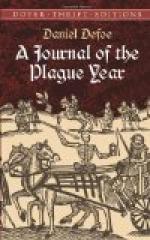Just in Bell Alley, on the right hand of the passage, there was a more terrible cry than that, though it was not so directed out at the window. But the whole family was in a terrible fright, and I could hear women and children run screaming about the rooms like distracted, when a garret window opened, and somebody from a window on the other side the alley called, and asked, “What is the matter?” Upon which from the first window it was answered, “O Lord, my old master has hanged himself!” The other asked again, “Is he quite dead?” and the first answered, “Ay, ay, quite dead; quite dead and cold!” This person was a merchant and a deputy alderman, and very rich. I care not to mention his name, though I knew his name too; but that would be a hardship to the family, which is now flourishing again.[137]
But this is but one. It is scarce credible what dreadful cases happened in particular families every day,—people, in the rage of the distemper, or in the torment of their swellings, which was indeed intolerable, running out of their own government,[138] raving and distracted, and oftentimes laying violent hands upon themselves, throwing themselves out at their windows, shooting themselves, etc.; mothers murdering their own children in their lunacy; some dying of mere grief as a passion, some of mere fright and surprise without any infection at all; others frighted into idiotism[139] and foolish distractions, some into despair and lunacy, others into melancholy madness.
The pain of the swelling was in particular very violent, and to some intolerable. The physicians and surgeons may be said to have tortured many poor creatures even to death. The swellings in some grew hard, and they applied violent drawing plasters, or poultices, to break them; and, if these did not do, they cut and scarified them in a terrible manner. In some, those swellings were made hard, partly by the force of the distemper, and partly by their being too violently drawn, and were so hard that no instrument could cut them; and then they burned them with caustics, so that many died raving mad with the torment, and some in the very operation. In these distresses, some, for want of help to hold them down in their beds or to look to them, laid hands upon themselves as above; some broke out into the streets, perhaps naked, and would run directly down to the river, if they were not stopped by the watchmen or other officers, and plunge themselves into the water wherever they found it.
It often pierced my very soul to hear the groans and cries of those who were thus tormented. But of the two, this was counted the most promising particular in the whole infection: for if these swellings could be brought to a head, and to break and run, or, as the surgeons call it, to “digest,” the patient generally recovered; whereas those who, like the gentlewoman’s daughter, were struck with death at the beginning, and had the tokens come out upon them, often went about indifferently easy




